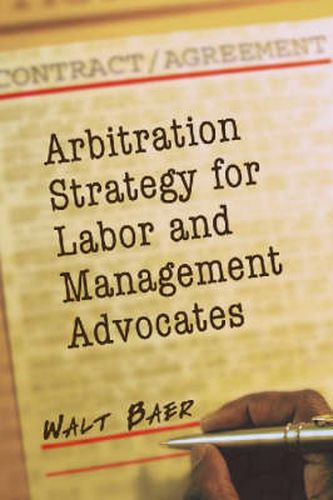Readings Newsletter
Become a Readings Member to make your shopping experience even easier.
Sign in or sign up for free!
You’re not far away from qualifying for FREE standard shipping within Australia
You’ve qualified for FREE standard shipping within Australia
The cart is loading…






This title is printed to order. This book may have been self-published. If so, we cannot guarantee the quality of the content. In the main most books will have gone through the editing process however some may not. We therefore suggest that you be aware of this before ordering this book. If in doubt check either the author or publisher’s details as we are unable to accept any returns unless they are faulty. Please contact us if you have any questions.
Today, 95 percent of all labor contracts in the United States provide for arbitration. Indispensable to sound contract management, arbitration orchestrates the resolution of disputes by a neutral third party. Since parties who reach the process of arbitration are no longer interested in compromise or mutual accommodation, arbitrators, unlike mediators, do not have to work out arguments or propose possible solutions. They simply hear evidence and make a decision based on the facts as presented - without being bound by rules of evidence or precedents. For both sides, the key to a successful outcome lies in their advocates’ ability to present and document their case. Providing guidance for labor and management advocates, this resource guide contains a practical analysis of arbitration from the participant side with a view to avoiding the problems and pitfalls of the process. Written for those who do not deal with the intricacies of arbitration on a day-to-day basis yet have a responsibility to their company should such situations arise, it begins with the very basics of the arbitration concept, including discipline and discharge procedures. It then provides detailed guidelines for presenting an organization’s position effectively, and it discusses important principles and practices every advocate should know. Additional topics include grievance procedure time limits; methods for researching and selecting the arbitrator; and recommendations regarding witness conduct. Practices of the actual arbitration such as objections, admissible evidence and credibility of evidence are also discussed. Extensive references to pertinent statutes and case law round out this informative guide.
$9.00 standard shipping within Australia
FREE standard shipping within Australia for orders over $100.00
Express & International shipping calculated at checkout
This title is printed to order. This book may have been self-published. If so, we cannot guarantee the quality of the content. In the main most books will have gone through the editing process however some may not. We therefore suggest that you be aware of this before ordering this book. If in doubt check either the author or publisher’s details as we are unable to accept any returns unless they are faulty. Please contact us if you have any questions.
Today, 95 percent of all labor contracts in the United States provide for arbitration. Indispensable to sound contract management, arbitration orchestrates the resolution of disputes by a neutral third party. Since parties who reach the process of arbitration are no longer interested in compromise or mutual accommodation, arbitrators, unlike mediators, do not have to work out arguments or propose possible solutions. They simply hear evidence and make a decision based on the facts as presented - without being bound by rules of evidence or precedents. For both sides, the key to a successful outcome lies in their advocates’ ability to present and document their case. Providing guidance for labor and management advocates, this resource guide contains a practical analysis of arbitration from the participant side with a view to avoiding the problems and pitfalls of the process. Written for those who do not deal with the intricacies of arbitration on a day-to-day basis yet have a responsibility to their company should such situations arise, it begins with the very basics of the arbitration concept, including discipline and discharge procedures. It then provides detailed guidelines for presenting an organization’s position effectively, and it discusses important principles and practices every advocate should know. Additional topics include grievance procedure time limits; methods for researching and selecting the arbitrator; and recommendations regarding witness conduct. Practices of the actual arbitration such as objections, admissible evidence and credibility of evidence are also discussed. Extensive references to pertinent statutes and case law round out this informative guide.